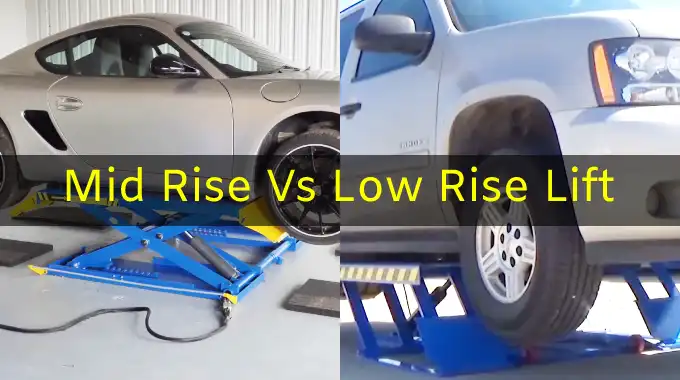Last Updated on February 28, 2023
Car lifts are becoming increasingly popular in car servicing shops because of their affordability and space efficiency. There are some major differences and drawbacks to these lifts that can impact the safety and longevity of your car.
The main difference between mid-rise car lifts and low-rise car lifts is the amount of vertical height lift they can provide. Mid-rise car lifts offer a higher lifting capacity, typically ranging up to 74 inches, while low-rise car lifts provide a more limited range, typically up to 40 inches.
This difference in lifting capacity makes mid-rise car lifts much better suited for tasks that require vehicles to be lifted several feet off the ground or when working on multiple levels of the vehicle.
Here, we will compare and contrast both options: giving you a better understanding of which type is right for your particular project. Keep reading if you’re ready to begin your journey toward finding the perfect model for your shop or home garage.
Mid Rise Vs Low Rise Lift: Main Differences
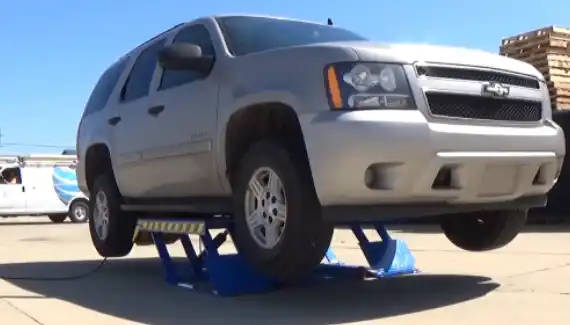
This section suggests a preference or trend toward using mid-rise car lifts instead of low-rise car lifts. This may indicate that people are finding mid-rise car lifts to be more efficient or effective in lifting cars in contrast with low-rise car lifts.
Increased Accessibility
Mid-rise car lifts offer increased accessibility compared to low-rise car lifts, as they can reach heights of up to 54 inches. They are equipped with more safety features and support up to 6,000 pounds making them durable enough for larger or heavier vehicles.
Four-point contact pads ensure a smoother lifting process and prevent damage due to uneven weight distribution or strain on the lift arms. Overall, mid-rise car lifts provide users with an improved level of convenience and safety when performing maintenance or repairs on their cars.
More lifting height
Mid-rise car lifts offer significantly higher lifting heights than low-rise lifts, with most models reaching up to 74 inches compared to just 40 inches. Mid-rise car lifts also feature greater lifting capacity, ranging from 4,000-6,000 lbs as opposed to 1,500-3,000 lbs.
Additional features such as adjustable arms and safety locks provide improved flexibility and convenience for users compared to low-rise models. Hydraulic cylinders and electronic control systems are in most mid-rise car lifts for smoother operations.
By offering higher lift heights, heavier weight capacities, and more convenient additional features. Mid-rise car lifts are suitable for more demanding automotive tasks than their low-rise counterparts.
Versatile for various tasks
Mid-rise car lifts are highly versatile and can accommodate different types of cars and light-duty trucks. They are perfect for larger tasks such as engine removal, axle assembly replacement, etc.
Low-rise car lifts allow the advantage of being closer to ground level, making it easier to get underneath the vehicle while servicing it. These lifts can be used on any vehicle, including smaller ones like motorcycles and ATVs.
Both mid-and-low rise car lifts offer advantages depending on the specific situation, allowing technicians to quickly access all four sides of a car or provide easy access beneath a vehicle.
Can be used for storage
Mid-rise car lifts typically offer more storage capacity than low-rise due to their greater lifting power and higher height. Mid-rise lift capability allows for storing furniture or other large items beneath them.
Low-rise lifts are limited by their lower lifting heights, reducing available storage space. Mid-rise models can accommodate heavier vehicles such as trucks and SUVs, while low-rise only fit smaller cars. Mid-rise car lifts bring greater storage potential due to their increased strength and higher elevation.
Consideration should also be given to the type of vehicle a lift can accommodate. Mid-rise models can typically lift heavier vehicles, such as SUVs and trucks, allowing larger items to be stored beneath them. In comparison to low-rise car lifts, mid-rise models offer greater storage capacity.
The Upvotes on Low-rise Car Lifts Over Mid-rise Car Lifts
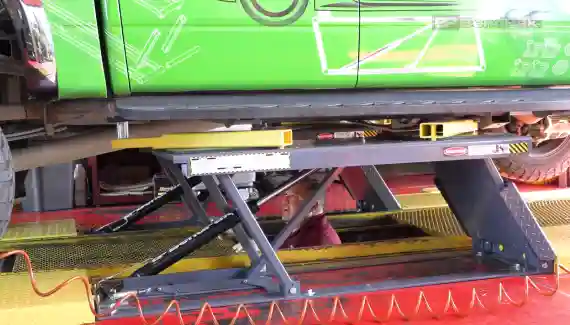
This section suggests a preference for low-rise car lifts compared to mid-rise car lifts based on the number of upvotes or positive feedback received.
This could indicate that people with experience with both car lifts believe that low-rise car lifts have certain advantages or benefits over mid-rise car lifts and are expressing their preference through their upvotes.
The reasons for this preference could vary, including cost, ease of use, safety, or space requirements.
Ideal for limited spaces
A low-rise car lift occupies little floor space and lifts up to 4,000 pounds. It has an emergency stop button and safety locks. It has a height range of 17″ to 39″.
These car lifts lift up to 6,000 pounds; heights range from 40″ to 72″. Additional safety features include drive-on ramps and adjustable locking systems.
The choice between the two types depends on the need and available space.
Easy to use and operate
Low-rise car lifts offer the advantage of being more lightweight and easier to move, ideal for workshops with limited space. They require less installation effort than mid-rise models.
Mid-rise car lifts provide greater lifting capacity and height, making them suitable for taller vehicles such as SUVs or pickup trucks. They often come with hydraulic power units or electric motors, making them easy to operate and maintain.
The best lift option for a given workshop depends on specific needs; it is essential to do research before making any decisions.
Suitable for low-clearance vehicles
Low-rise car lifts provide greater flexibility for servicing low-clearance vehicles with a small profile for fitting in lower ceilings.
Mid-rise car lifts are better suited for servicing light-duty trucks with higher clearances, as they can lift from 6″–42″.
Both options are suitable depending on specific needs and preferences.
Less expensive
Low-rise car lifts are costly and require more floor space, making them less cost-effective than mid-rise lifts for low-clearance vehicles. Larger or heavier vehicles can be lifted in mid-rises, as well as taller vehicles like trucks and vans.
Although low-rises offer greater stability when lifting, they lack the height to service certain areas of some vehicles. Mid-rises may be prone to movement during operation due to their higher center of gravity.
Despite the initial expense, mid-rises will pay for themselves over time with reduced labor costs and increased efficiency from faster job completion times.
Which Lift Is More Reliable In Terms Of Durability And Reliability?
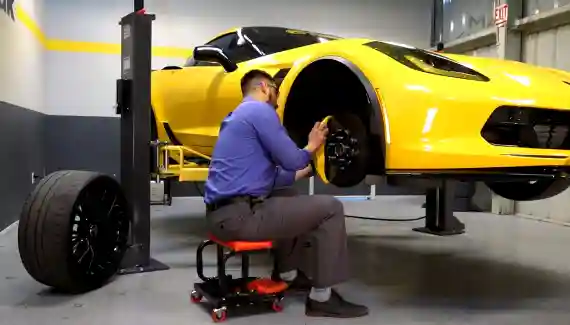
Mid-rise lifts are constructed with heavier-duty components and have greater capacity, making them suitable for heavier vehicles and equipment. Low-rise lifts feature lighter materials and are better suited for light vehicles, such as motorcycles or ATVs.
Both mid-rise and low-rise lifts are renowned for their reliability, require minimal maintenance, and feature precision components to ensure smooth operation. Depending on the application’s needs, either mid-rise or low-ride models may be chosen.
Whichever lift is chosen will be dependable and effectively get the job done right.
Which Lift Is Better In Terms Of Producing A Low Noise Level?
Low-rise car lifts are designed with acoustic enclosures, providing sound dampening during operation. Mid-rise car lifts produce excessive noise and can be disruptive in the workplace.
Low-rise car lifts contain soundproofing materials to reduce sound levels further while running. Most mid-rise car lifts do not have this added insulation, generating much higher levels of noise when operating. Low-rise car lifts are superior for producing a low-noise level workspace.
Which Car Lift Is Better Based On Installation Requirements?
When it comes to installation requirements, both low-rise car lifts and mid-rise car lifts have their own unique advantages.
For starters, a mid-rise car lift requires more ceiling clearance than a low-rise car lift to accommodate its larger size. This can be inconvenient for those with low ceilings in their garages and shops.
On the other hand, a low-rise car lift requires much less ceiling clearance than its mid-rise counterpart, making it an excellent option for those with limited space or low ceilings.
Which Car Lift Is Better For The Types Of Installation Methods and Steps?
Low-rise car lifts are typically easier to install due to their simplified design. The installation process starts by laying out and bolting base frame components. Posts are then bolted onto the unit’s base frame.
Connect and adjust hydraulic cylinders or electric/pneumatic jacks according to the manufacturer’s instructions. Any additional components, such as pulleys or chains, must be added.
Mid-rise car lifts have a more complex design than their low-rise counterparts and require more assembly. Installation of a mid-rise lift involves bolting columns and beams together, connecting wiring, and other components such as chains or pulleys.
An alignment procedure must ensure everything is level before attempting the operation. The additional steps taken during the setup of a mid-rise lift can often take longer than required for a low-rise model.
Thus, low-rise car lifts are quicker and easier to install than mid-rise models. They feature a more straightforward design with fewer assembly steps than the latter requiring additional alignment once installed before utilization.
A Comprehensive Comparison for Your Needs: Mid-Rise Car Lift Vs. Low-Rise Car Lift
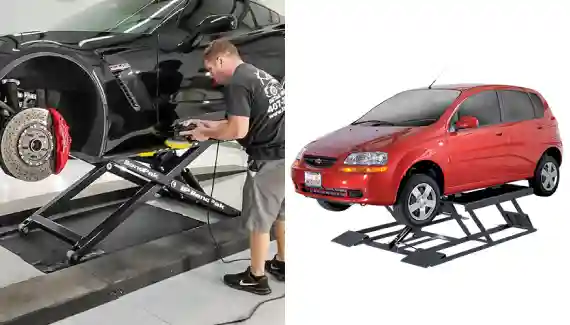
After reviewing the upshots and drawbacks of both the mid-rise car lifts and the low-rise car lifts, it is clear that each lift has its own particular strengths. Mid-rise car lifts provide increased accessibility, more lifting height, and versatility for various tasks.
In contrast, low-rise car lifts are ideal for limited spaces, are easy to use and operate, and are suitable for vehicles with low clearance. Ultimately, your particular needs will help you decide the type of lift that is better in terms of reliability and durability, as well as installation requirements, methods, and steps.
Given the many factors that play into understanding the differences between both types of car lifts, such as their size, capabilities, and cost, it’s essential to understand all your options before deciding.
Always do a bit of research so you can get the most out of your purchase or upgrade. Be sure to read our other articles if you need more information or guidance on which type of lift is right for you. Thanks for reading our blog post.
